Due to Evolutionary Differences, Ponies Require a Different Feed Management Program, Not Just a Scaled-Down Ration for Optimal Health
Ponies are adorable. Their small stature and big personalities are magnetic and fun for — not only children — but equine enthusiasts of all ages. However, when it comes to nutrition, ponies require some extra care and should not be treated just as small horses. Today’s ponies have evolutionary differences requiring careful feeding management, more than simply dosing down what we feed our full-size horses.
The ancestors of many modern pony breeds originated in cold climates and the rough, mountainous terrain of Northern Europe. These early ponies had to endure harsh winters when food was scarce and foraged for the majority of the day seeking out the fibrous, low-quality native vegetation available to carry them through to the warmer months of spring when nutritious grass returned. Because of these dietary conditions throughout a significant portion of the year, many types of ponies evolved to be more metabolically efficient. Their natural seasonal rhythm was to gain weight in the spring and summer and rely on those fat reserves through the harsh winter months. Ponies’ evolution programmed them to put on weight when food is readily available and store these excesses as fat throughout the body. This played a key role in helping these small, hardy animals endure their environment. Ponies are often said to be “thrifty” — genetically better adapted to survive harsh conditions. While the actual structure and function of the digestive tract is similar to other hindgut fermenting equines, ponies efficiently digest and derive calories from fiber to maintain body condition. They are better able to maximize the energy content from tougher fiber sources, essentially extracting more from less. Ponies also tend to have a lower energy requirement and may burn up to 15% fewer calories at maintenance compared to their standard horse counterparts.
What is a Pony?
A pony is a small horse measuring less than 14.2 hands (58 inches) at the withers. Ponies tend to have specific conformational and temperamental differences that distinguish them from horses. Compared to horses, ponies are heavier boned and shorter legged in proportion to their bodies. They are robust and incredibly strong for their size. They tend to have thicker coats, manes and tails, and tough hooves. Ponies are intelligent, mature more quickly than horses and have a longer life span.
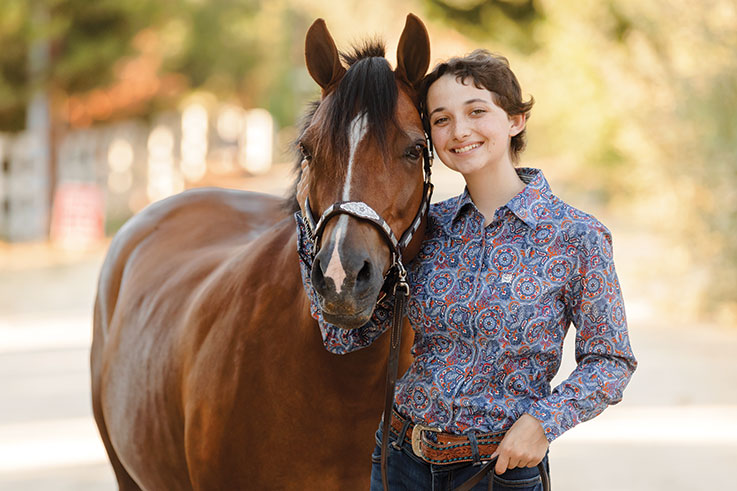
Sara Schimke and a pony named Bo, who is owned by Sarah Frushhour.
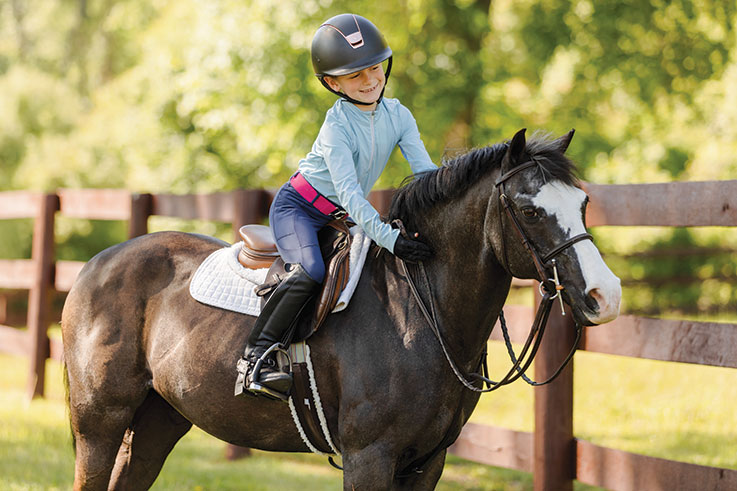
Lilly, daughter of 4-time Olympian McLain Ward, and her pony Chico.
The ancestors of many modern pony breeds originated in cold climates and the rough, mountainous terrain of Northern Europe. These early ponies had to endure harsh winters when food was scarce and foraged for the majority of the day seeking out the fibrous, low-quality native vegetation available to carry them through to the warmer months of spring when nutritious grass returned.
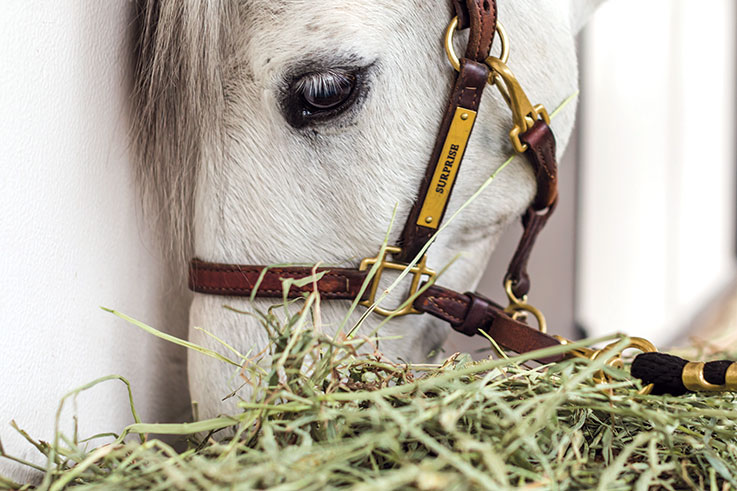
Sample Pony Diet
Mature 500-pound Pony at Maintenance
- 10 pounds grass hay (10-12% NSC) (4.5 kg)
- 1 scoop Platinum Performance® Equine (66 grams)
- 1/2 Tbsp salt (7 grams)
- 1 scoop Platinum Balance® (6 grams)
- Free choice water
Today, ponies in the United States are far from their rugged ancestral environments and are often fed too much of the “good stuff;” their historic thriftiness puts them at risk for developing several obesity- related and metabolic health issues. Some pony breeds are less insulin sensitive and, paired with a slower metabolism, tend to easily gain weight. Issues such as insulin resistance (IR), equine metabolic syndrome (EMS) and laminitis are serious health problems associated with weight gain that can not only reduce comfort, but the longevity of the animal as well. Routine veterinary care is critical. Along with regular vaccinations, dental check-ups and a deworming schedule, the veterinarian can offer objective opinions to gauge a pony’s overall body condition. Recommendations may include blood tests for a complete blood profile, as well as endocrine status for insulin resistance and pituitary pars intermedia dysfunction (PPID, equine Cushing’s disease), which have an increased prevalence in some ponies. Evaluating body condition based on a body condition score (BCS) chart is a great tool for identifying when dietary adjustments are needed. Keeping ponies at an ideal body weight is proactive health care, and knowing what to feed — and what to avoid — is the best way to ensure your pony maintains a healthy weight.
What to Avoid
Many ponies are prone to weight gain, obesity and obesity-related health issues. Avoid feeding choices that are high in calories, sugar or starch to keep your pony healthy.
- Lush pastures (especially in the spring) may be too high in sugar and fructans
- Cereal grains (corn, oats, barley, wheat) that are inherently high in starch
- Grain-based commercial feeds, even in small quantities, likely will exceed energy requirements for most ponies
- Sweet treats
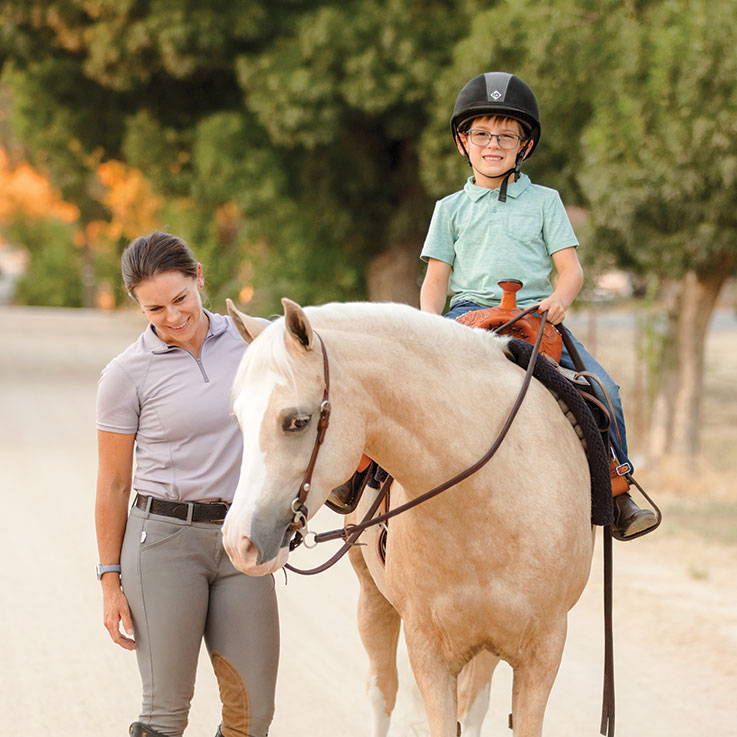
Melissa Reuter-Wagoner and her son Liam, who is riding Waverly — owned by Sarah Frushhour.
Feeding Your Pony
A maintenance diet for ponies should include grass hay, a comprehensive omega-3 fatty acid, vitamin and mineral supplement, salt and fresh water.
1. Hay
Choose a mature, grass hay that has a low nonstructural carbohydrate (NSC, which contain fructans, sugar and starch) level, less than 15% combined. Timothy, orchard grass, coastal or brome grass hays are typically suitable options. Hay that is cut late is more mature and tends to have lower energy content.
Ponies are foragers that do best with consistent access to fibrous feeds for a healthy digestive tract. Several small meals spread throughout the day may work best. Hay nets or slow feeders can increase the time it takes them to eat. Weigh your hay, and feed 1.5-2% of the pony’s body weight per day.
2. Supplements
A comprehensive vitamin and mineral supplement that is nutrient dense but low in sugar and starch content can safely balance the diet. Omega-3 fatty acids, an essential fat with a wide spectrum of health benefits, are especially important for ponies not on pasture. Individual ponies may require other supplements — including probiotics or joint support formulas — for optimal health.
3. Salt
Plain, white salt should be available free choice.
4. Hydration
Fresh, clean water should always be available.
Feeding ponies should be simple. Many ponies are famously considered “easy keepers” meaning that they seem to maintain or gain body condition on a minimal amount of feed. Forage, recognized as the base of every pony’s diet, provides all of the digestible energy and protein as well as the majority of vitamins and minerals needed daily for general health. Most ponies do not need concentrates, which are high in calories, and often sugar, to maintain a healthy weight. Grains and commercial concentrated feeds are often touted as “needed” nutritional sources for horses and ponies, but forage actually provides the majority of these essential nutrients and delivers it in a high-fiber way that emulates the natural diet. Often overlooked is an equine digestive tract that thrives on consistent fibrous bulk for digestive health. Ponies have an innate need to chew long-stemmed roughage and require a minimum of 1% of their body weight daily of high-fiber feeds to allow for normal motility of the digestive tract and prevent colic and ulcers. The digestive tract relies on a steady flow of forage and simply does not function properly without it. Forage as the foundation, or entirety, of the diet is the healthiest feeding choice for all ponies.
The Skinny Pony
Not every pony looks like a Thelwell drawing. Each pony is an individual, and while the majority hold weight well, some may need more calories to maintain body condition. Higher caloric intake may be required to support growth, pregnancy, lactation or performance. Once your veterinarian has checked that the pony’s teeth are in good shape with no health complications, if your pony requires more energy or calories to facilitate weight gain or maintain a healthy weight, opt for low-sugar options. Before reaching for grain, first try maximizing forage. Quality grass hay can be fed free choice to promote weight gain. Alfalfa can be very useful for thin ponies and can be added in a 50/50 blend of grass hay to alfalfa. Alfalfa cubes or pellets may be soaked and used as well. A general rule of thumb is to feed 2-3% of body weight in hay per day to promote weight gain. For a 500-pound pony, that translates to 10-15 pounds of hay. Flakes of hay can vary widely in weights, and it is good to know how much the pony is actually receiving each day, even if given free choice, in order to make adjustments. Feeding a “super fiber” like unmolassed shredded or pelleted beet pulp is an alternative for high-fiber and healthy calories. Healthy oils, such as flaxseed oil, also provide beneficial omega-3 fats that can be top-dressed onto most any feed and are another easy way to boost calories and not compromise sugar levels. Supplementing with a probiotic can nurture the beneficial bacteria in the hindgut and increase feed efficiency. Any feed changes (including hay) should be made slowly over 7-10 days to allow the hindgut microbial population to adjust.
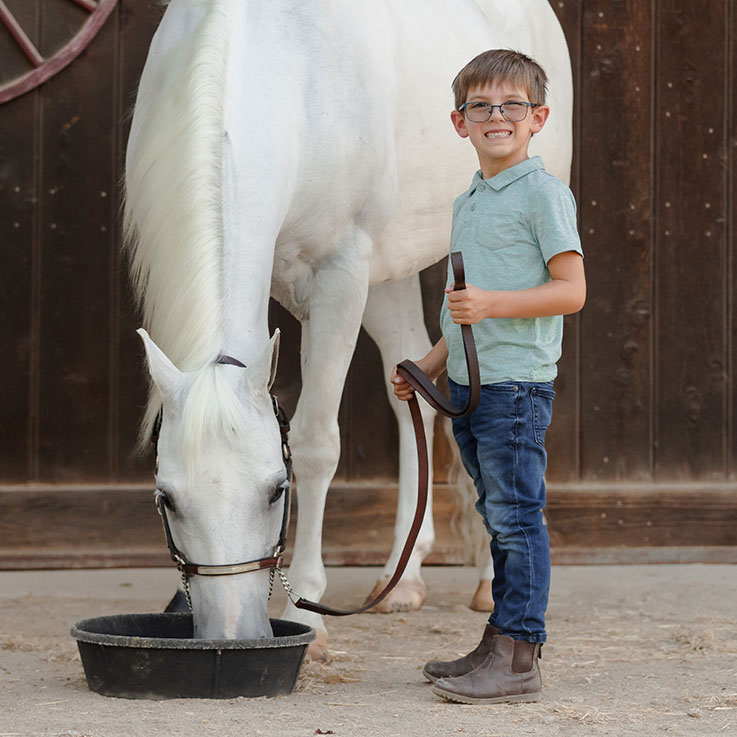
Platinum for Ponies
Daily Wellness
Platinum Performance® Equine
Provides a comprehensive foundation with omega-3 fatty acids, antioxidants, vitamins and trace minerals.
Metabolic Health
Platinum Metabolic Support
Magnesium and chromium support blood glucose maintenance and insulin effectiveness.
Digestive Support
Platinum Balance™
A daily pre- and probiotic formula with glutamine to support digestion and hindgut health.
Use of a comprehensive omega-3 fatty acid, antioxidant, vitamin and trace mineral supplement or commercial balancer pellet can fill any dietary gaps in a forage-based diet without the extra calories. Grasses and hays may have variable levels of certain nutrients depending on where or when they are grown. Most horse owners don’t analyze their hay or pasture, and it is impossible to know what may be lacking in forage just by looking at it. Using a veterinary-formulated, comprehensive equine wellness formula can provide peace of mind and take the guesswork out of feeding ponies.
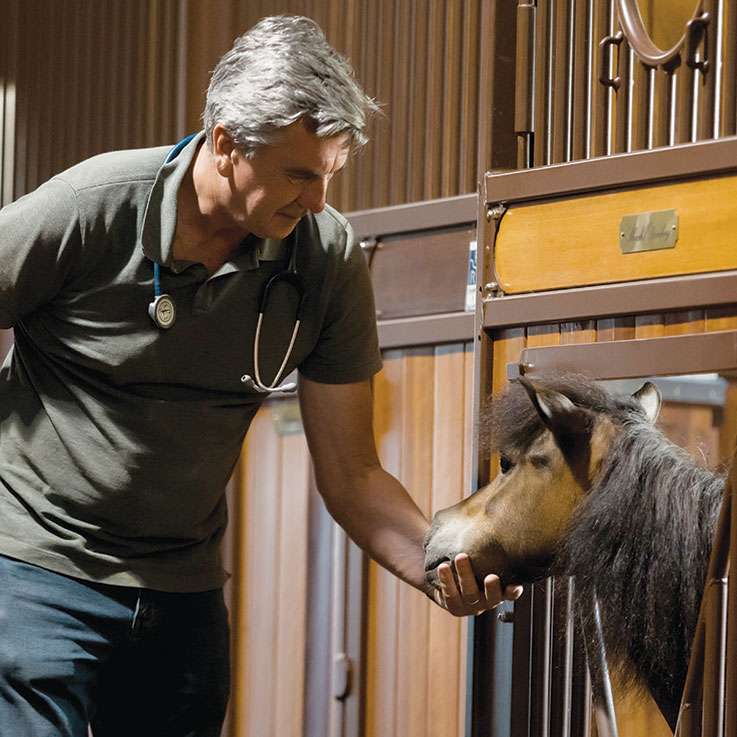
Dr. Philippe Benoit checks in on a small pony. Even if your pony is overweight, it is important to not feed less than 1% of the pony's body weight.
PHOTOS BY ELIZABETH HAY PHOTOGRAPHY
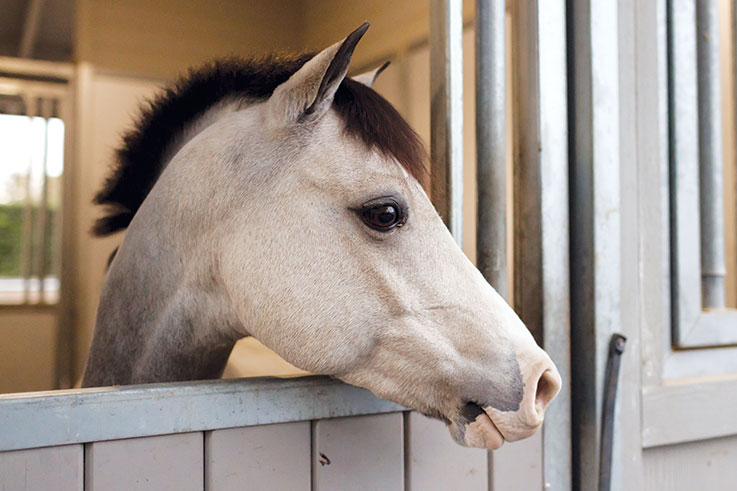
Fat to Fit
How to Feed an Overweight Pony
Overfeeding, feeding a diet heavy in non-structural carbohydrates, as well as a sedentary lifestyle are all linked to obesity. Obesity can lead to several health issues including insulin resistance, equine metabolic syndrome and laminitis. Many pony breeds are prone to being overweight and an obese body condition. If possible, exercise is excellent for ponies as it supports insulin sensitivity and helps maintain healthy blood glucose and insulin levels as well as a healthy weight. For all overweight ponies, the diet can be used to return the animal to a healthy body condition.
Supporting weight loss in ponies should be done carefully and slowly with gradual changes to a new, modified diet over four to six weeks to avoid putting the body in starvation mode. It is important to avoid an extremely restrictive or “crash dieting” to foster weight loss; do not feed less than 1% of the pony’s body weight per day. For a 500-pound pony, that is no less than 5 pounds per day. Weight loss that occurs too rapidly can potentially cause a serious health issue called hyperlipidemia — excess fat (triglycerides) in the blood. Hyperlipidemia, which can be deadly, is sometimes seen with extremely restricted feed intake.
The goal of feeding for weight loss is to maximize time spent “grazing” or chewing long-stem forage to support healthy digestion while minimizing calorie intake. Ponies need fibrous bulk in their digestive system for health as well as to prevent boredom and behavior issues like weaving and cribbing. A healthy diet based on forage with low sugar and starch content is key to re-establishing and maintaining a healthy weight in ponies.
3 Steps to Lose Weight
1. Weigh In
Have your veterinarian perform annual wellness checks. The veterinarian can determine the pony’s body condition and look for early signs of health problems. Watch for signs of metabolic issues including obesity, difficulty losing weight, a cresty neck and other localized fat deposits. Track weight and body condition fluctuations in overweight ponies, and notify your veterinarian if you observe any of these signs or any changes in body condition or eating patterns.
It is extremely helpful to know how much your pony weighs in order to correctly feed the animal. Some veterinary clinics have a walk-on livestock scale that provides the most accurate weight. While weight tapes work well for most horses, it may be a better estimate for a pony’s weight to use this equation: ((heart girth x heart girth) x body length) / 300. These simple measurements taken in inches will equal approximate body weight in pounds. From there, you can get a better idea of how much total feed to give your pony daily. For example, a 600-pound pony on a diet of 1.5% of their body weight should receive 9 pounds of hay per day. What you feed your pony may seem like a small amount, especially for those ponies on a restricted diet or if you are also feeding bigger horses. Experts suggest weighing the actual amount of feed instead of just eyeballing amounts, which can be deceiving and inaccurate.
2. Feed Me Forage
For ponies on a restricted diet, it is still necessary to provide consistent access to fiber to support a healthy digestive tract. Ponies are capable of consuming hay very quickly. Slow feeders or smallhole hay nets allow access to forage throughout the day while increasing time spent eating. Maintain overweight ponies on a hay that is lower in sugar and digestible energy (calories). Later-cut hay — stalkier and less rich and digestible than young, green hays — are a better choice for ponies that need to lose weight.
A hay analysis provides valuable information about its nutrient values, including sugar, starch and calorie content. The non-structural carbohydrate concentration in hay is a general measurement of the sugar, starch and fructan concentration in forage. From the hay analysis, the NSC is calculated by adding the water-soluble carbohydrates (WSC) and starch values. Ponies requiring limited starch and sugar should receive forage with an NSC concentration that is between 10-12% or below. If the hay contains a higher than desirable sugar content, consider soaking it to lower the NSC value. About 60 minutes in cold water, or 30 in warm water, will dissolve much of the water-soluble sugar content and make it more appropriate for many ponies.
To help with weight loss, ponies may need to stay in a dry lot with hay instead of turned out on pasture. Ponies can gorge and are capable of eating up to 5% of their body weight in a day. If a pony is on pasture, use a pony-specific grazing muzzle that can help to limit gorging. Use caution especially during the spring when new grass growth can be rich and sugar and starch levels are peaking. For ponies returning to pasture or being turned out on new spring grass, increase turnout time in 30-minute increments to allow the hindgut microbiome to adjust and to avoid intestinal disturbances.
3. Skip Dessert
Overweight ponies do well on a hay-only diet and should not be fed grain, grain-based feeds or sweet treats as the high energy and sugar content can inhibit weight loss and promote obesity. It is important to still provide all of the essential nutrients needed for health on a calorie-controlled diet. Hay may not supply all of the necessary vitamins, minerals and omega-3 fats required for optimal health. Supplement with a comprehensive daily wellness supplement to fill in common nutritional gaps from a forage-based diet without oversupplying calories. Certain nutrients, like chromium and magnesium, support normal blood sugar levels and a healthy metabolism. The amino acid carnitine helps support better calorie utilization and promotes weight loss, especially when used with exercise.

